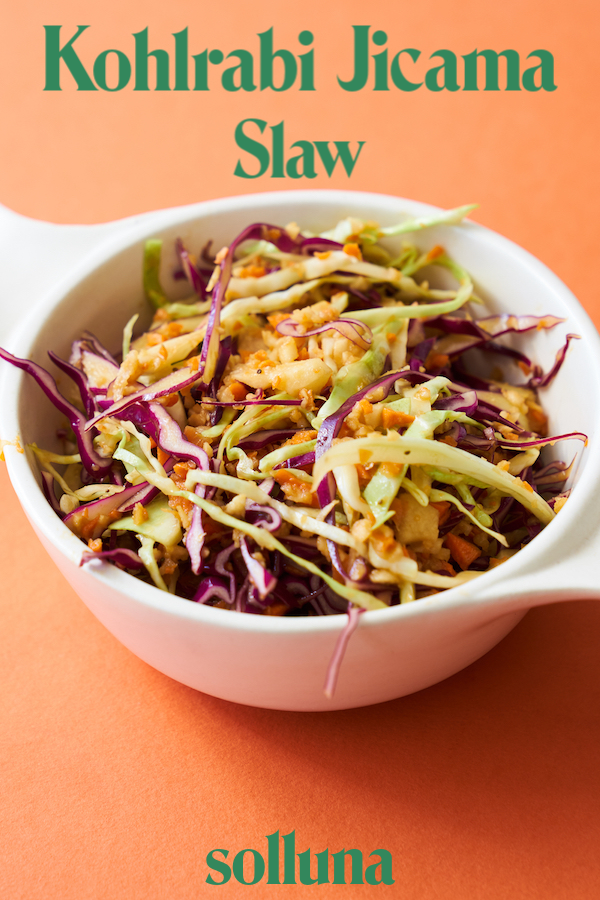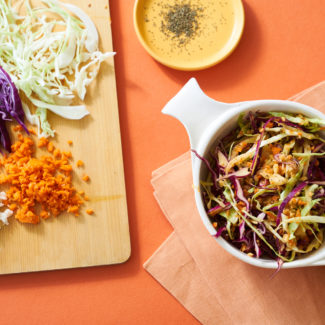
Have you ever tried kohlrabi, Beauty? It shares a texture similar to the stem of broccoli but with a sweeter and milder taste. I saw some beautiful kohlrabi while I was walking through the market the other day. It was so eye-catching that I just had to pick one up!
Oftentimes I let the produce speak to me like this. When we open our minds, we can hear our inner voice trying to guide us into discovering what nutrients and energy from food that we need in our lives. Hence the inspiration for my Kohlrabi Jicama Slaw. The combination of kohlrabi, jicama, carrots, and cabbage make this slaw a powerful energy force that does wonders for your body!
Uncovering Kohlrabi
I love to introduce new foods to my friends and family. So if kohlrabi is new to you, let me share with you why it deserves a spot in your kitchen. Kohlrabi is also referred to as the German “turnip”, yet it doesn’t fall into the same category. It is actually the same species as cabbage, broccoli, kale, and cauliflower.
This beautiful veggie can be deliciously prepared in a variety of ways. For my Kohlrabi Jicama Slaw recipe, kohlrabi, as well as all the other veggies, remains raw. This way you can get as much of their nutritional benefits, without losing anything from cooking.
Kohlrabi comes in a variety of colors like white, purple, and soft green. Each tastes slightly different but all share the same amazing nutritional value.
Just one serving of kohlrabi provides you with 75% of your daily vitamin C needs! That’s enough to really support glowing skin and boosting immunity. It also is a great source of vitamin B6 and minerals like manganese, phosphorus, and potassium.
Your eyes and skin get a major boost from kohlrabi, too. It helps reduce everything from arthritis to a stuffy nose and watery eyes, due to its anti-inflammatory action.
When you are out getting your ingredients for my Kohlrabi Jicama Slaw, look for smaller, unblemished kohlrabi bulbs that are heavy for their size. If the bulbs have leaves, cut them off, and store the bulbs and the leaves separately in the refrigerator for up to a week.
The Soft Secrets of Jicama
Jicama is also a powerful veggie that, more often than not, might not get the attention that it deserves. Jicama can be sweet and juicy in flavor and makes the perfect snack to keep on hand around the home. Like many vegetables, jicama is low in calories but high in nutritional value!
It’s super hydrating and filled with rich sources of fiber, vitamin C, potassium and inulin. In case you haven’t heard, inulin is actually a “prebiotic”. It is a type of fiber that the body can’t digest. Rather, it feeds your body’s friendly flora, helping to restore the natural balance in your system.
Do you know what else helps re-balance the levels of friendly bacteria in your system? My broad spectrum of Feel Good SBO Probiotics. They are the single best way to restore digestive health. Check out my formula to learn how this simple addition to your routine can help promote your overall well-being, beauty, and immunity!
And don’t forget to keep an eye out for jicama at your local market or health market. It’s pretty common, but you may have never seen it because you’ve never looked!
I hope this post inspires you to try out my new Kohlrabi Jicama Slaw. It’s super simple to make and will stay nice and fresh for several days in your refrigerator! Don’t forget to tag me in all your recipe creations on Instagram. Also, pin the picture above to your Pinterest board for all your followers to see.

Kohlrabi Jicama Slaw
Ingredients
SLAW INGREDIENTS
- ½ purple kohlrabi thinly sliced
- ½ small green cabbage thinly sliced
- ½ jicama shredded
- 1 carrot shredded
DRESSING INGREDIENTS
- 2 ½ Tbs. apple cider vinegar
- 1 ½ Tbs. extra virgin olive oil
- 1 ½ Tbs. coconut nectar
- ½ Tbs. Dijon mustard
- ½ tsp. celery seeds
Sending you lots of love Beauty,



What is coconut nectar, and what can I substitute for it? Love the idea of this recipe—it looks so greasy and crunchy!
Hi Feebee…coconut nectar is a naturally sweet, nutrient-rich, low glycemic sweetener. So when the coconut tree is tapped, it’s actually producing a ‘sap’ that exudes from the coconut blossoms. This sap has a very low glycemic index score and contains 17 amino acids, minerals, vitamin C, broad-spectrum B vitamins, and nearly neutral pH. Being raw and enzymatically alive, this is an ideal sweetener and one I personally love to use. If you don’t have any handy, try using an organic local honey. Let us know what you think and sending you lots of love! ;)
Love, love your recipes you make the transition of becoming vegetarian easy. Feel very satisfied and don’t miss the meat. And best of all feel so good
Love it Line Savoie! Thanks so much for checking out my recipes and thrilled to hear you’re enjoying them all! Be sure to tag me on Instagram when you make a dish and want to share! Lots of love to you! ;)